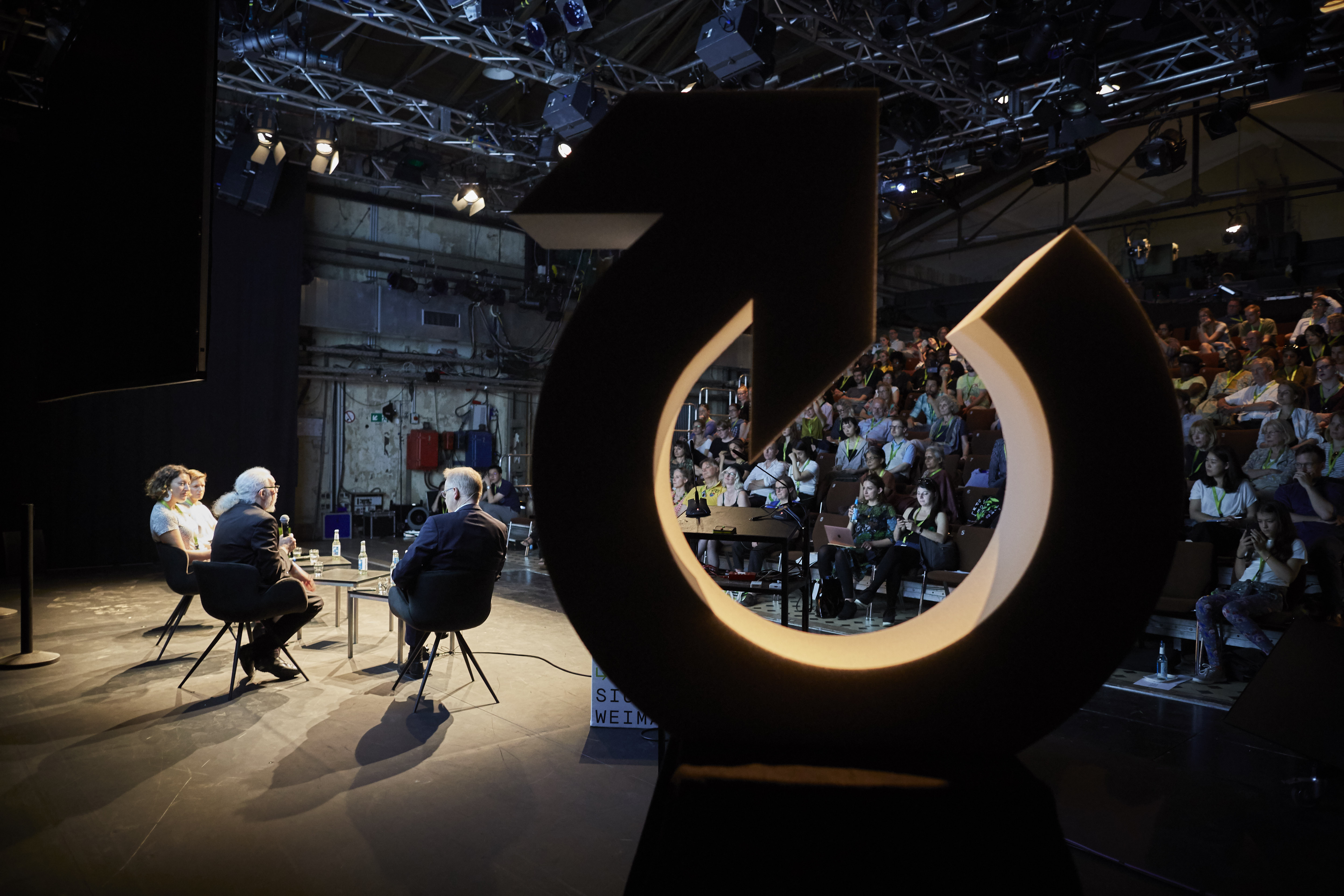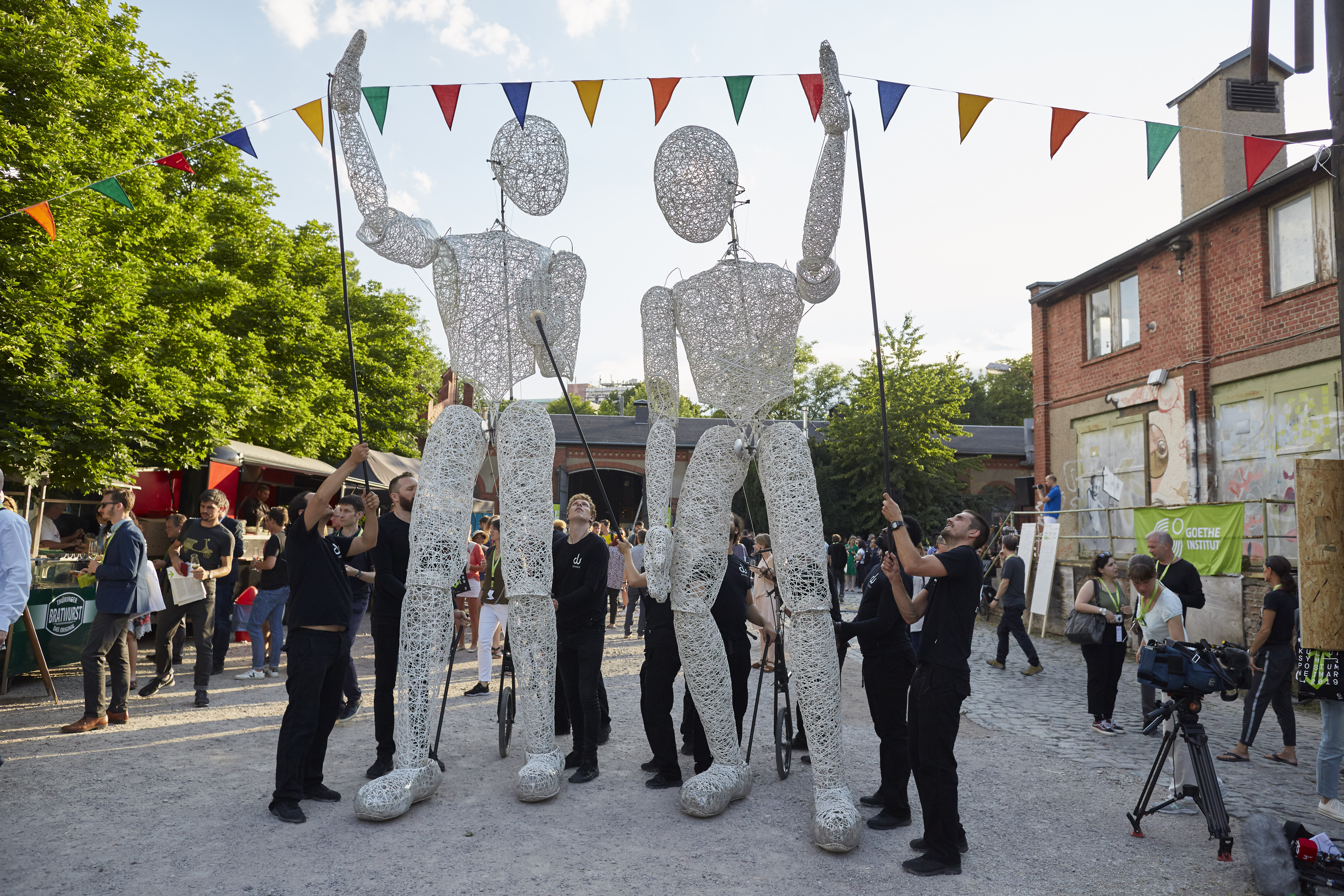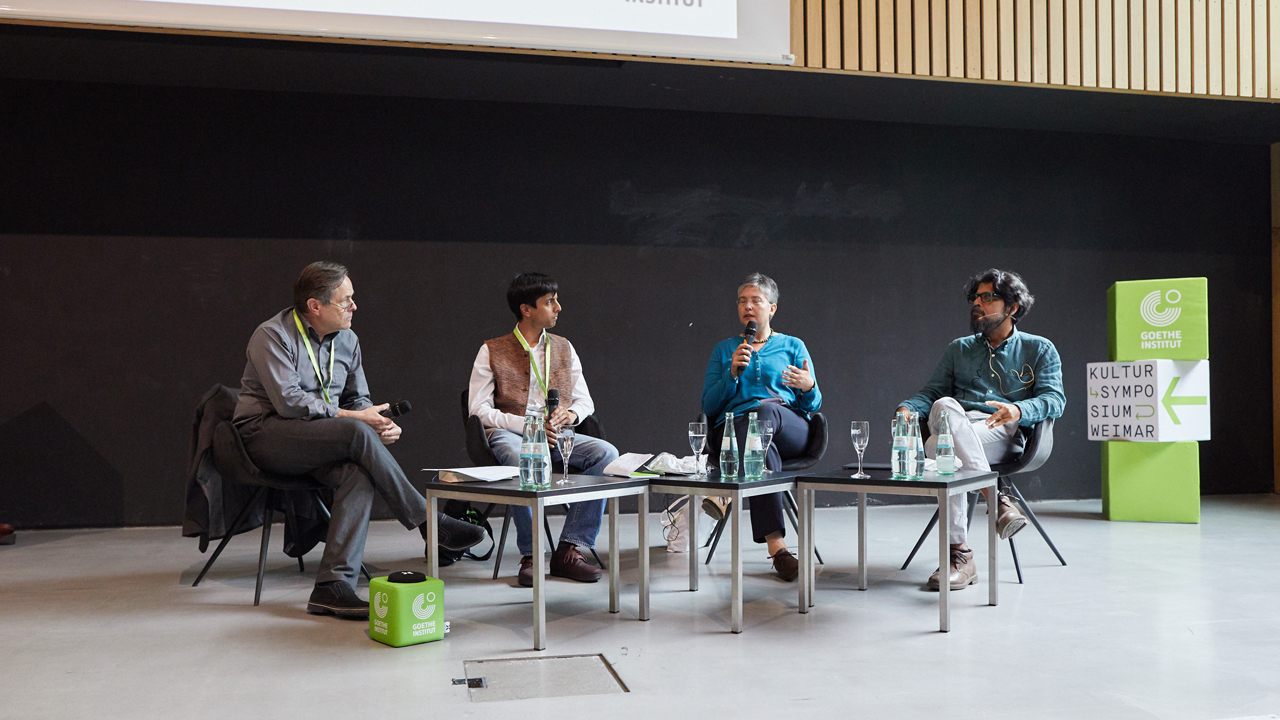Kultursymposium Weimar 2019 | 19-21 June
Festival report
"NOT MACHINES ARE THE PROBLEM; IT’S PEOPLE"
A report on Kultursymposium Weimar 2019 by Kirsten Riesselmann
 Kultursymposium Weimar 2019
Kultursymposium Weimar 2019
GATHERING CUMULATIVE GLOBAL KNOWLEDGE
The Kultursymposium Weimar is now taking place for the second time following the one in 2016. This year, under the motto “Recalculating the Route,” the Goethe-Institut has invited experts from all over the world and arranged a two-and-a-half-day program of lectures, panels, performances, and film screenings, which attempts an in-depth exploration of the urgent issues of our time. In order to provide a sense of orientation in a world that is becoming ever faster and seemingly more complex, it aims to address the rapidly changing relationship between humans and technology, living and working environments controlled by algorithms and artificial intelligence, public life on social media, the tech economy, but also and not least, the political developments—the shift to the right and nationalism—that can be observed worldwide, as well as the changing conditions for cultural production.
Nonetheless, the opening act is still rather light-footed and poetic: Baby Dundu and Giant Dundu, one small and one very large manikin, delicately constructed from white synthetic fibers and controlled by puppeteers with rods. They stride, run, and jump through the hall. Onstage, they try out the sofa and the lectern, interact with the audience; their gestures and movements playfully anticipating what will happen over the next few days. Then Klaus-Dieter Lehmann, president of the Goethe-Institut, welcomes over 500 participants from 70 countries. Thanks to the variety of perspectives represented in Weimar, he hopes that the present and future will be understood not only as a risk but also as an opportunity. The symposium aims to “bring together accumulated global knowledge and perhaps find an answer or two,” but equally to provide “stimulating, exciting, and enjoyable days.”
BAD AIR
In her subsequent keynote speech, “Why I build future scenarios,” designer Anab Jain—she described herself as an “archaeologist of the future”—presented how she avoids the feeling of powerlessness and being overwhelmed in the face of information overload, deepfakes, a wavering concept of truth, and deceptive glossy surfaces: she makes the consequences of our actions physically tangible, lets us feel how today’s decisions affect tomorrow. For example, she blew air from the year 2030 directly into the face of Dubai’s traffic planners; the air, that is, if the Emirates don’t ease up on automobiles. Dubai is now promoting the expansion of its metro and electro-mobility.
The symposium’s participants left the opening on foot. The Dundus led them to the event center, the E-Werk site, in a long train. Bar tables and food stalls, an open tent, the Lichthaus cinema, the engine room, and the sprawling courtyard were waiting to be seized. The Zürich band Steiner & Madlaina struck up, and the first conversations were underway without much ado. It was easy to start one, whether with the curator from Barcelona, the artist from Algeria, the cultural manager from Ukraine, the talk show host from Malaysia, the documentary filmmaker from Hong Kong, or the alternative sex shop owner from Leipzig—there was a lot of curiosity about each other, and great candor. At some point, everyone had on wireless headphones and was dancing to the silent disco as the evening cooled, with music provided by three DJs in the decommissioned tram car.
 Kultursymposium Weimar 2019 - Eröffnungsabend
Kultursymposium Weimar 2019 - Eröffnungsabend
LEAP IN AND BE OPEN
Over the next two days, participants made their way through the 50 or so symposium events, dashing from the E-Werk to the Bauhaus-Universität on a rental bike and continuing on to the study center at the Herzogin Anna Amalia Bibliothek. They studied the jam-packed program over and over, which was divided into four focal points: “ORIENT // ATION, ” “AUTO // NOMY,” “RE // GRESSION,” and “DIGI // NOMICS.” They discussed what they had just heard in the coffee breaks, which were often too short, and asked about what they had missed. “Were you at the lecture about chimpanzees and how they see the world?,” “How was ‘The Future of Work’?,” “Who's coming to the human-robot dance performance tonight?” Often, the only option was to plunge in and get involved, even and especially among all the gloom that had to be negotiated. And to firmly believe—and experience—that the joint search for a solution provides enough relief and understanding.
CONFLICT AS DIALOGUE
At the panel “Cultural Policy Under Pressure,” the circumstances described by two theater-makers and an artist from PiS’ Poland, Bolsonaro’s Brazil, and Duterte’s Philippines were all depressing. It became glaringly obvious how quickly fundamentalist Christian politics with absolutist values that explicitly divides into black and white can suppress oppositional voices, how quickly hostility toward art and intellectualism takes on menacing proportions, how quickly experimentation and criticism also fall victim to self-censorship. Marta Keil from Warsaw and Antônio Araujó from São Paulo agreed, albeit skeptically, that the task of the cultural scene in such a situation is to define a “common ground” from which to talk to one another, to seek contact with the opposition, and to find a way to frame dispute as dialogue.
CAPITALISM VS. DEMOCRACY
The global democracy crisis was also addressed by Pankaj Mishra, who—as the author of the book The Age of Anger—has investigated right-wing populism as a response to feeling economically and technologically left behind. In the main auditorium of the Bauhaus University, Mishra explained the antagonistic goals of capitalism and democracy: democracy wants everyone to be equal, but capitalism wants the exact opposite, since profit can only be made by following the logic of unequal economic development. Liberal democracy seems to have little chance in the face of a populism that consolidates those left dissatisfied by capitalism into democratic majorities, and then immediately and authoritatively rallies them against the democratic ideal of equality. Professor of constitutional law Ece Göztepe had one suggestion for its salvation: social media clearly hasn’t created the kind of public sphere necessary for a true democracy—this needs to be reclaimed. Mishra hoped for “fresh ideas” in this regard—they will emerge when people start to see the future as less rosy than the present. Pretty soon, then. When the discussion was opened up, the omnipresent throwable microphone—a softly padded cube—flew back and forth across the lecture hall like a ball of wool in an icebreaker activity. The contributions from Angola, Venezuela, and the Congo were eye-opening for European complaints about the democracy crisis, which were uninformed by postcolonialism, and once more shifted the local situation into another context.
The US economist Denise Hearn also criticized extremely unequal distributions of power. She cited sector concentration in the tech industry and the emergence of a few giants in Silicon Valley as a massive problem for the prospect of controlled development and a more equal distribution of value creation. 93% of all online searches today are through Google, with almost 70% of global data traffic occurring on Internet platforms that belong to the Google or Facebook empire. Hearn urgently implored us to reconsider the dogma of “the winner takes all!”. We needed to take action against monopolization, pass new laws against mergers that are too large, and, simply put, to stay vigilant.
 Kultursymposium Weimar 2019 - Paneldiskussion
Kultursymposium Weimar 2019 - Paneldiskussion
HUMAN AND MACHINE
This question, “How do we get the matter back into our own hands?”—and the inevitable question, difficult as it is essential, subsequently posed by participants from Africa “And who actually is this we?”—was negotiated multiple times in relation to technology. The Australian AI expert Toby Walsh was quite alone in his enthusiasm for machines becoming smarter and smarter, the brave new world of driverless vehicles, and the potential applications of facial recognition. The Norwegian robot developer Karen Dolva advocated for development led by concrete problems rather than technical possibilities. The British AI researcher Noel Sharkey was of a similar opinion: machines should help, not command, but anthropomorphism is increasingly becoming a problem in dealing with machines. According to Sharkey, machines would never be able to make ethical decisions, feel real feelings, or enter into a real relationship with humans. Robots were not well-suited for overcoming social isolation, they exacerbated it. Mari Matsutoya’s report from Japan, however, fed the suspicion that people would rather fall head over heels into the fantasy of a relationship with an AI lover, a hologram pop star, or even with their pillow.
During the next coffee break, you could put on VR glasses in the test station of a live escape game, shoot balloons with a virtual bow and arrow, and save humanity in only ten minutes—congratulations! A truly fleeting illusion of agency. Immediately after, the discussion about “The Brutalization of Language in Political Discourse” robbed us of any hope that it would be similarly easy to salvage what remained of the Internet’s former promise. Claudia Roth, vice president of the German Bundestag, spoke of the “brutal radicalization of language” since the AfD entered parliament, “hate and incitement to hatred in parliamentary speeches,” and the hostility, insults, and death threats that she regularly receives online. Media expert Anna Szilágyi added that “verbal abuse” is still being downplayed, and that words could be just as destructive as deeds. Artist Carlos Celdran called for Facebook to be classified as a “crime scene” and for platforms such as Twitter and Instagram to be held more accountable. Szilágyi then pleased for not only an appropriate response, but also a proactive narrative, a democratic alternative plan. However, the question of what this would look like remained open. The hope lay—not for the first time—with “the young people,” those bidding farewell to Facebook and demonstrating at Fridays for Future.
FRIGHTENED AND YET INSPIRED
Before the final session people exchanged business cards and email addresses and ate one last slice of Thuringian apple pie. Then the moderator asked: “Have we reached our destination?” and prompted the four panelists for a closing statement. And so the essayist Panashe Chigumadzi from Zimbabwe, the journalist Juan Carlos Rincón from Colombia, Denise Hearn, and Toby Walsh attempted the almost impossible and compiled a colorful potpourri of the topics and approaches discussed during the Weimar summit: they advocated a New Green Deal informed by postcolonialism, as well as for opportunities for socially sustainable development through the use of indigenous knowledge. Machines were defended; ultimately the problem wasn’t them, but rather the people behind them. New forms of effective communication were invoked that could bring hate, incitement to hatred, and misrepresentation to their knees. Like an optical illusion, optimism shifted toward pessimism and back again. Rincón arguably gave the best summary: “Here, I was both inspired and alarmed. But I think we can look to the future in good spirits—we just have to remain engaged and vigilant.”
With this in mind, there was great joy when Goethe-Institut Secretary General Johannes Ebert announced in closing that there would be another meeting in Weimar in 2021. By then, many will be able to find their way there without their smartphone. Or discover the pleasure of getting lost while still being able to arrive. Or know that you could also just ask people on the street.
About the author
Kirsten Riesselmann is a journalist and translator of Adrian McKinty, Elmore Leonard and DBC Pierre among others. She resides in Berlin.
July 2019